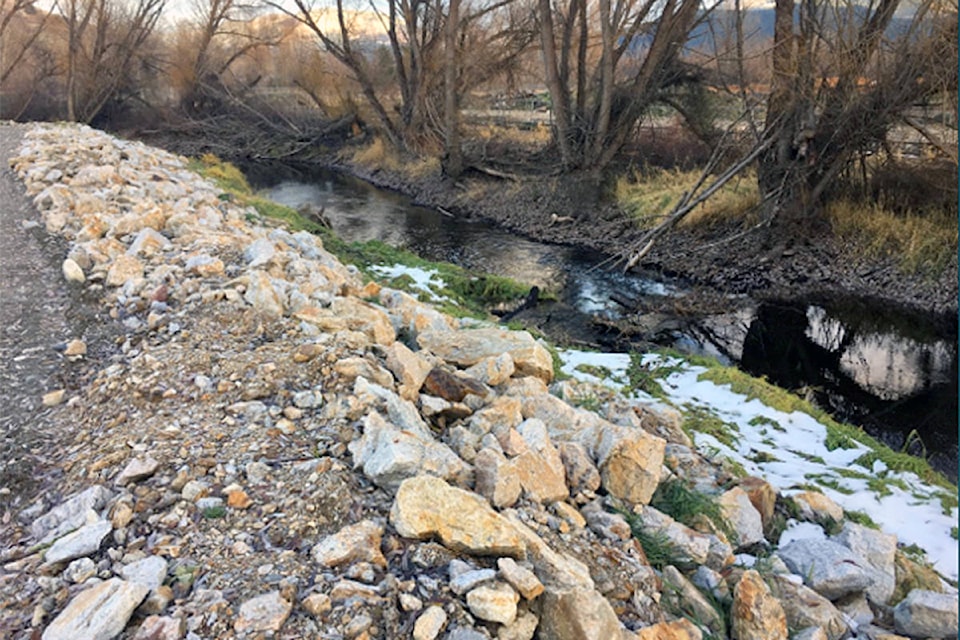Lumby’s temporary berm will have to come out, provincial and federal government officials say.
Dwayne Meredith, senior project manager with Kerr Wood Leidal consulting engineers, outlined the two-phase removal process during a public hearing at the Whitevalley Community Centre Wednesday, Jan. 16.
However, with phase one — the removal of works above the two-year high watermark — slated to begin in February before spring freshet, some of the approximately 60 members of the public in attendance were apprehensive of the project’s timeline.
“Legally, the works are not up to the long-term flood prevention standards the community needs,” Meredith said, noting that policy dictates temporary berms of this magnitude are to be removed after six months.
Trevor Bohay, resource manager with the Ministry of Forests, Lands, Natural Resource Operations and Rural Development, said that leaving the temporary berm in could lead to a false sense of security — a sentiment echoed by Department of Fisheries and Oceans Canada officer Melissa Korhonen.
Funded by Emergency Management BC, the berm was installed as an emergency response to flooding in 2017 that saw a peak discharge of 44.6 cubic metres per second. The agency’s quick response means that the 2017 temporary flood protection works were never intended to withstand the pressure of future floods.
“When you constrain a floodplain, you create a bit of a tipping point,” said Darryl Hussey with the Department of Fisheries and Oceans. “When temporary dikes are left in, it can be dangerous.”
Related: Some Lumby residents forced to evacuate
Related: Flood costs swamp Lumby
Vernon-Monashee MLA Eric Foster, who attended as a member of the public, questioned why the removal plan didn’t detail any long-term prevention mechanisms as Lumby has seen substantial flooding over the course of his 35 years in the area.
“Spend the money now. Do it right, and we never have to do it again,” Foster said.
Mayor Kevin Acton said that the Village is in conversation with the various ministries involved, but, as of right now, there is no prevention funding in place.
“This time, this is the option that was available to us and this is what we built. There is not a lot of money for doing this ahead of time. There’s no real money in prevention — it’s for a response. We’ve been trying to spread it (the lifespan of the temporary berm) out to get a plan in place,” Acton said. “Let’s look at what we’re going to do in the future.”
Before that future plan is finalized, Acton said the Village will have to continue to use temporary measures such as sandbagging.
Related: Lumby flood work on time, budget
The second phase of the temporary berm’s removal will see the removal of all remaining works as soon as conditions permit. Remediation and the counter-acting of stream and riparian damages will also begin during this phase.
Some Village of Lumby residents said they were concerned about the remediation process and its impact on their personal properties upon which the berm was created. Fences, sheds and trees were removed during the process and residents said that they want them back.
Acton said that the remediation plan is still in consultation, but the Village has records of all the damage sustained by local properties and will be going through that replacement process with the province. Meredith added that land owner’s participation is critical to the project.
Beyond the damage to personal property, the Department of Fisheries and Oceans said that flood protection work does negatively impact Chinook and Coho salmon habitats throughout Bessette and Duteau creeks.
“From our perspective, it’s a bit of a shame,” Hussey said. “If residual damage is happening to the environment, there’s an obligation that it gets repaired. We do consider it a very important habitat.”
A full-time environmental monitor will be employed throughout the berm’s removal to help mitigate further impact on the fish habitats.
parker.crook@vernonmorningstar.com
Like us on Facebook and follow us on Twitter.
